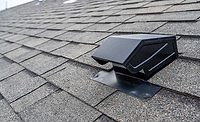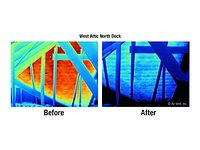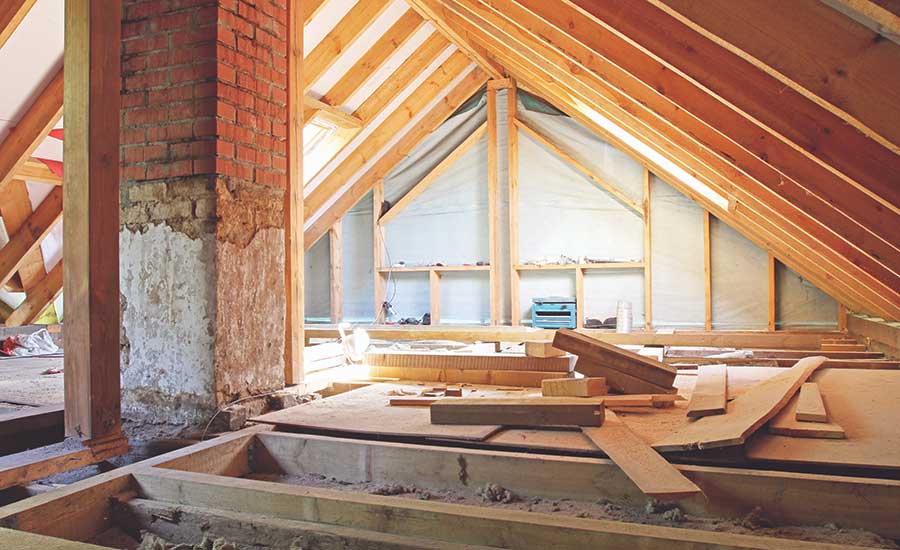How Roofing Contractors Can Help Clients with Insurance and Attic Ventilation Upgrades
After the Storm


Storm-damaged roofs are the perfect opportunity to fix attic ventilation mistakes such as mixing two types of exhaust vents (box and wind turbines) on the same roof. Photo courtesy of Bill West Roofing.

Box vents have limitations and some roofing contractors in storm-prone markets are getting upgrades covered by homeowners’ insurance. Photo courtesy of ABM Services and Renovations.

The ideal time to upgrade from box vents that provide localized airflow to ridge vents that allow continuous airflow is during a roof replacement. Photo courtesy of ABM Services and Renovations

New exhaust vents installed on the roof need intake vents to perform correctly — unlike this one. Check the condition of the intake vents and confirm nothing inside the attic is blocking the airflow. Photo courtesy of EPIC Exteriors.





The weather forecast looks poor. Strong winds, heavy rain and the possibility of hail — golf-ball-sized or larger — could hit the area. The storm strikes, and many houses are damaged to the point roof replacement is necessary. Homeowner’s insurance will pay the cost of the new roof and the attic ventilation, but what if the vents that were in place don’t meet code requirements? Will homeowner’s insurance pick up the tab? And what if the contractor recommends a better, more efficient way to vent the attic different than the vents that were in place? Will insurance pay for the upgrade?
Some roofing contractors in storm-prone markets are successfully convincing homeowner’s insurance to pay. Here’s how.
Point to Building Code Requirements
A key way to get insurance companies to pay the cost of an attic ventilation upgrade — if in fact an upgrade is needed — is to document that the existing attic ventilation system doesn’t meet current minimum code standards. Obviously, that involves knowing what the local code standards are. The International Residential Code specific to attic ventilation is IRC Section 806. Local municipalities are free to adopt the IRC word-for-word or write their own variation of that code. Roofing contractors say documenting what the storm-damaged roof currently has for attic ventilation vs. what the minimum code standards are should convince insurance companies to cover the cost.
“If the homeowner has building code coverage written into their policy I can usually get the insurance company to pay,” said Irving Napert, president of Futura Building Systems, of Dallas. “I obtain memos from inspectors, policies, emails, letters and personal meeting notes with building officials. And I always have business cards so I can give it to the insurance adjuster. With this data, I create the reasons why ventilation must be paid for by the insurance company. I must reiterate that building code coverage in the insurance policy is the only way I have found that any insurance company will pay for the upgrades in attic ventilation. Thankfully, I’m batting (100 percent) in that every house I find under-ventilated I get the necessary money from the insurance company.”
Napert isn’t the only one with a strong batting average on behalf of homeowners. “If code requirements are not met, we give the insurance company proof of the code and they will honor it,” said Gary Bowling, residential sales and project manager for Lakeside Roofing in Collinsville, Ill. “This strategy always works. We show them the code and explain how it helps the roof meet its life expectancy.”
“If the policy holder has ‘building codes upgrade coverage,’ I address it under that area since it’s a building code upgrade for most older homes,” noted Rodney Wright, owner of Wright Construction and Roofing, LLC, in Acworth, Ga. “The insurance company is obligated to pay for an attic ventilation upgrade of some sort — whether it’s improving from box vents to ridge vents or just increasing the number of box vents or wind turbines. And don’t forget about intake vents to balance the attic ventilation system.”
If push comes to shove, it may be time to request a special letter. “Sometimes insurance companies are very resistant to paying unless a building code official or city official writes a pointed letter to the insurance company in regards to city enforced code requirements,” said Sean Jegen, owner of Gorilla Exteriors Contracting, LLC, in Shawnee, Kan. “I’ll request such a letter on behalf of the homeowner.”
It’s worth pointing out that by “upgrade” these roofing contractors aren’t simply talking about making sure the amount of attic ventilation meets building code standards. It also includes opportunities to improve the type of vents. If box vents or wind turbines can be replaced with more effective ridge vents, that’s the route these roofing contractors take.
“In the Kansas City market we get a lot of hail storms. Hail storms are a good opportunity for attic ventilation upgrades,” said Shawn Bellis, owner of EPIC Exteriors in Overland Park, Kan. “A code enforcement claims specialist/storm damage restoration contractor can navigate the insurance policy to determine if the homeowner is eligible for an attic ventilation ‘tune-up.’ Many times it’s possible to supplement the insurance claim to provide a balanced attic ventilation system with the proper amount of intake and exhaust vents.”
Emphasize Shingle Warranty
If there isn’t a local building code to enforce attic ventilation — and compel insurance companies to pay — roofing contractors like Andy Matyszewski emphasize the shingle warranty. “In order to comply with the shingle manufacturer’s warranties, I explain the importance of a balanced attic ventilation system to both the insurance company and the homeowner, as well as the mortgage company where applicable. Balanced attic ventilation, that is, intake and exhaust vents in the amount required for the attic square footage, protects the roof investment. All parties involved should be interested in this because it helps protect against future claims,” said Matyszewski, owner of ABM Services and Renovations, Inc., in McDonough, Ga.
“I explain the improvement in terms of heat and moisture inside the attic through proper ventilation, improved comfort inside the home and compliance with the shingle warranty,” Jegen said. “The shingle warranty is tied to proper attic ventilation because it impacts the life span of the shingles.”
There are also the vent manufacturer’s installation instructions to consider. Beyond detailing how to install the vents, the instructions detail what’s needed for the vents to perform correctly and most efficiently. Specifically, the installation instructions highlight the need for a balanced “system” of intake and exhaust vents. Thus, ridge vents need intake vents. Box vents need intake vents. All exhaust vents need intake vents. Armed with the shingle manufacturer’s warranty and the vent manufacturer’s installation instructions, insurance companies may agree to pay for the attic ventilation upgrade.
Wright said he keeps copies of the code and the vent installation instructions handy to pass along to insurance adjusters as needed. “When the manufacturer’s installation instructions supersede the code or is not addressed in the code, the installation instructions apply. I’ve surprised many adjusters when I show them this statement in the code.”
Separate Yourself from the Pack
When insurance rejects paying for an attic ventilation upgrade for the new roof but the contractor knows it’s needed nonetheless, two options remain: ask the homeowner to pay for it or the contractor could absorb the cost.
“This is where I feel I’m different from most roofers,” Napert explained. “I have paid for parts of the project out of concern for the customer and the roof warranty. If a roof is not properly vented the shingles will lose the warranty protection after 10 years. I can’t do that to the homeowner. We do not advertise that we do roofs. All of our work is by referral and I think this is why.”
“I actually automatically build an attic ventilation upgrade into my cost structure unbeknownst to my homeowners,” Matyszewski said. “So in the event no other funds are available from the insurance company, I still install the balanced attic ventilation system at no charge. I’ll reveal that as a bonus because most of my business is word-of-mouth referrals and any ‘bonus’ tends to make customers feel special and leaves everything on a good note.”
But the roofing contractor doesn’t have to pay if the homeowner is willing to pay the cost for the attic ventilation upgrade after learning the benefits it can deliver.
“We will always recommend an upgrade to the attic ventilation system when necessary and inform the homeowners why it’s the better way,” said Aaron West, vice president of Bill West Roofing, Inc. in Grain Valley, Mo. “We’ll do what we can to educate them on the benefits. Often they’ll pay. But we will eat the cost when necessary to service the customer. It boils down to doing the project correctly and servicing the customer.”
“Once you take the time to explain why and educate the homeowner on a ‘ventilation system,’ it’s rare for them not to give us the go ahead,” Bowling added.
“We’ll offer the upgrade at cost but not free unless referrals are already provided and contracted,” Jegen said. “If that’s the case, we’ll give them the product upgrade vs. paying a referral fee.”
“I see this as an opportunity to distinguish myself from the herd with a passion for balanced attic ventilation,” Bellis explained. “I will thoroughly explain to the homeowner how the system reduces attic heat buildup, moisture buildup, improves indoor comfort and fulfills the shingle warranty. More often than not the homeowner is willing to pay.”
“I demonstrate optimal ventilation for the homeowner’s particular attic square footage and help educate them on the importance of preventing moisture and heat buildup,” said Matyszewski. “Then I explain the cost savings associated with higher efficiency from the balanced attic ventilation system. Homeowners are willing to pay when it’s explained this way.”
Looking for a reprint of this article?
From high-res PDFs to custom plaques, order your copy today!










